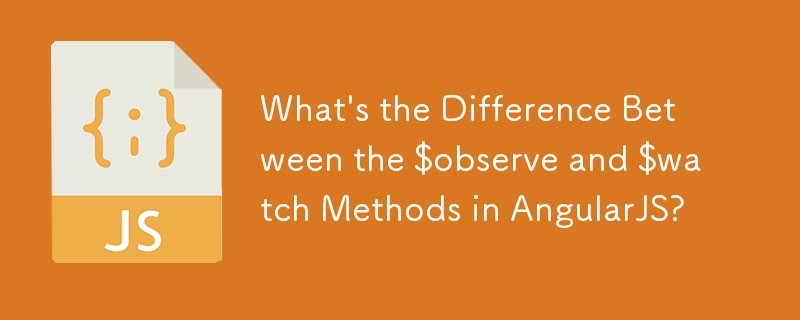Home >Web Front-end >JS Tutorial >What\'s the Difference Between the $observe and $watch Methods in AngularJS?
What\'s the Difference Between the $observe and $watch Methods in AngularJS?
- Patricia ArquetteOriginal
- 2024-10-19 16:38:30641browse

Difference between the $observe and $watch Methods in AngularJS
AngularJS utilizes both Watchers and Observers to monitor changes in the $scope object. While both react to alterations in $scope, there are key differences between the two.
$observe:
- Method available on the Attributes object
- Solely watches the value change of DOM attributes
- Primarily used within directives
- Suitable for observing attributes containing interpolation ({{}})
$watch:
- Method on the Scope object
- Monitors an "expression," either a function or a string
- Strings are evaluated as Angular expressions, excluding {{}}
- Can be employed in controllers and linking functions
- Often used to observe model/scope properties
Asynchronous Nature of Attributes with Interpolation:
Attributes that include interpolation are not evaluated immediately. Hence, $observe and $watch are essential for handling them asynchronously.
Recommendations:
If an isolated scope is not being used, $watch is recommended. For isolated scopes with attributes containing interpolation, $observe should be preferred for consistency.
Example Use Cases:
- $observe: Observe the value of attr1="Name: {{name}}" within a directive.
- $watch: Monitor the myModel.some_prop property in a controller.
Additional Notes:
- Both $observe and $watch are executed during each digest cycle.
- Directives with isolated scopes allow $observe or $watch for interpolated attributes in the case of the @ syntax.
- Direct evaluation ($eval()) can be used for attributes containing numbers, booleans, or constant strings.
The above is the detailed content of What\'s the Difference Between the $observe and $watch Methods in AngularJS?. For more information, please follow other related articles on the PHP Chinese website!
Related articles
See more- An in-depth analysis of the Bootstrap list group component
- Detailed explanation of JavaScript function currying
- Complete example of JS password generation and strength detection (with demo source code download)
- Angularjs integrates WeChat UI (weui)
- How to quickly switch between Traditional Chinese and Simplified Chinese with JavaScript and the trick for websites to support switching between Simplified and Traditional Chinese_javascript skills

